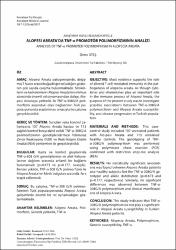| dc.contributor.author | Ateş, Ömer | |
| dc.date.accessioned | 2018-07-03T07:16:49Z | |
| dc.date.available | 2018-07-03T07:16:49Z | |
| dc.date.issued | 2017 | |
| dc.identifier.uri | http://kocatepetipdergisi.aku.edu.tr/wp-content/uploads/2017/03/2-Omer-ATES.pdf | |
| dc.identifier.uri | http://hdl.handle.net/11630/4898 | |
| dc.description.abstract | Amaç: Alopesi Areata patogenezinde, değişmiş
T hücre aracılı bağışıklığın rol aldığını gösteren
çok sayıda çalışma bulunmaktadır. Sitokinlerin
ve kemokinlerin Alopesi Areata’nın immun
sürecinde önemli rol oynamasından dolayı, Alopesi
Areata’ya yatkınlık ile TNF-α-308G/A polimorfizmi
arasındaki olası bağlantının Türk populasyonunda
araştırılması amacıyla bu çalışma
gerçekleştirildi.
GEREÇ VE YÖNTEM: Sunulan vaka kontrol çalışmasına
107 Alopesi Areata hastası ve 113
sağlıklı kontrol bireyi dahil edildi. TNF-α-308G/A
polimorfizminin genotiplendirmesi Polimeraz
Zincir Reaksiyonu (PZR) ve Restriksiyon Enzim
Analizi (REA) yöntemleri ile gerçekleştirildi.
BULGULAR: Hasta ve kontrol gruplarında
TNF-α-308 G/A genotiplerinin ve allel frekanslarının
dağılımı arasında anlamlı bir bağlantı
bulunamadı (p=0.673 ve p=0.177, sırasıyla).
Benzer şekilde, TNF-α-308 G/A polimorfizmi ile
Alopesi Areata’nın klinik bulguları arasında fark
tespit edilemedi.
SONUÇ: Bu çalışma, TNF-α-308 G/A polimorfizminin
Türk populasyonunda Alopesi Areata
gelişiminde önemli bir rol oynamadığını göstermektedir. | en_US |
| dc.description.abstract | Most evidence supports the role
of altered T cell-mediated immunity in the pathogenesis
of alopecia areata. As though cytokines
and chemokines play an important role
in the immune process of Alopesi Areata, the
purpose of the present study was to investigate
possible associations between TNF-α-308G/A
polymorphism and Alopesi Areata susceptibility,
and disease progression in Turkish population.
MATERIALS AND METHODS: This casecontrol
study included 107 unrelated patients
with Alo-pesi Areata and 113 unrelated
healthy controls. The genotyping of TNFα-308G/A
polymorp-hism was performed
using polymerase chain reaction (PCR)
combined with restriction enzy-me analysis
(REA).
RESULTS: No statistically significant associations
was found between Alopesi Areata patients
and healthy subjects fort the TNF-α-308G/A genotypic
and allelic distribution (p=0.673 and
p=0.177, respectively). Similarly, no significant
differences was observed between TNF-α308G/A
polymorphism and clinical manifestations
of Alopesi Areata.
CONCLUSION: This study indicates that TNF-α308G/A
polymorphism do not play a significant
role in Alopesi Areata susceptibility in Turkish
Alopesi Areata patients. | en_US |
| dc.language.iso | tur | en_US |
| dc.publisher | Afyon Kocatepe Üniversitesi, Kocatepe Tıp Dergisi | en_US |
| dc.rights | info:eu-repo/semantics/openAccess | en_US |
| dc.subject | Alopesi Areata | en_US |
| dc.subject | Polimorfizm | en_US |
| dc.subject | Genetik yatkınlık | en_US |
| dc.subject | TNF-α | en_US |
| dc.title | Alopesi areata’da tnf-α promotör polimorfizminin analizi | en_US |
| dc.title.alternative | Analysis of tnf-α promoter polymorphism in alopecia areata | en_US |
| dc.type | article | en_US |
| dc.relation.journal | Afyon Kocatepe Üniversitesi, Kocatepe Tıp Dergisi | en_US |
| dc.department | Gaziosmanpaşa Üniversitesi, Tıp Fakültesi | |
| dc.identifier.volume | 18 | en_US |
| dc.identifier.startpage | 7 | en_US |
| dc.identifier.endpage | 12 | en_US |
| dc.identifier.issue | 1 | en_US |
| dc.relation.publicationcategory | Makale - Ulusal Hakemli Dergi - Kurum Yayını | en_US |



















